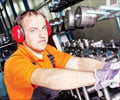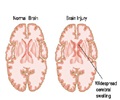Scientists say that the brain may be injured by the noise produced by the firing of anti-tank weapons or a howitzer.
Scientists at the Sahlgrenska Academy in Sweden say that the brain may be injured by the noise produced by the firing of anti-tank weapons or a howitzer.
Having shown mild injury to brain tissue, their study prompted the Swedish Armed Forces to restrict the number of rounds per day their personnel could be exposed to.While a number of reports in the past have suggested that the brain seems to be sensitive to the blast, the current study focused on how whether the occupational standards for the highest levels of blast exposure were valid enough to avoid brain injuries.
Scientists at the Sahlgrenska Academy, University of Gothenburg, Sweden examined the effects of noise after the firing of a Haubits, an anti tank weapon (Karl Gustav), and an automatic rifle and by the detonation of plastic explosives underwater.
The study was done on anaesthetized pigs and rats.
We examined the maximal peak level of the blast in the brain transmitted from the blast in the air, as well as, brain tissue changes that were detected with the microscope, says Annette Saljo, one of the scientists who conducted the study.
The researchers noticed that the noise produced by the firing of both the haubits and the anti-tank weapon exceeds the occupational standards for highest levels of blast exposure.
Advertisement
According to them, their findings showed that the degree of transmission of a pressure wave from air or water to the brain depends on the dominating frequencies in the frequency spectrum of the noise; low frequencies are transmitted considerably better than high frequencies.
Advertisement
They further observed that blast exposure leads to the development of brain edema, i.e. increased fluid content, a finding that they were later able to support this finding with other measurements.
The researchers said that the results of their study were in agreement with findings in the brains of soldiers who had been injured or died after being exposed to explosions in wars, from WW1 to the war in Iraq.
Based on their observations, the team came to the conclusion that the maximal peak levels of blast generated by the firing of certain weapons led to a small but measurable effect on the brains of pigs and rats.
The study also showed that this effect on the brain becomes worse with increasing maximal peak blast levels.
The results poses the question as to whether exposure to even lower levels of blast than previous thought injurious might be contributing to the large numbers of mild traumatic brain injuries in American military personnel.
This is of course an occupational question for Swedish Armed Forces. In light of the results of the study, the Swedish military has instituted restrictions in the number of firing rounds a person is allowed to be exposed to in a single day, says Annette Saljo.
Source-ANI
SPH














